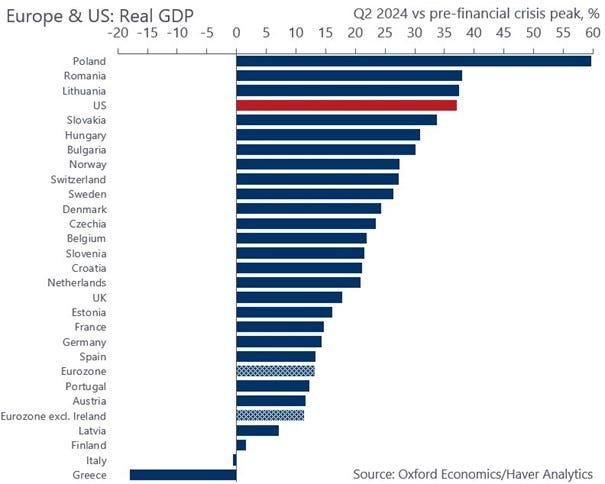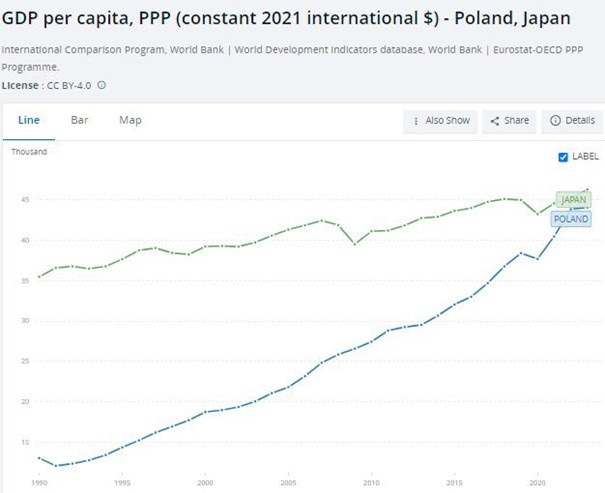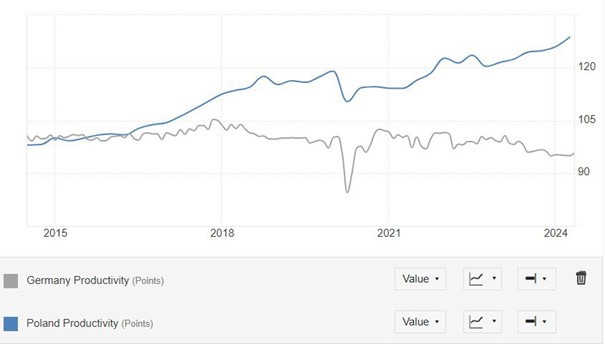Poland: A Rising Star in Europe
What the economic boom in Poland has to teach the rest of Europe
Why Poland Is Winning
Sometimes, a country surprises you. Poland is one of those countries. If you’d looked at it in 1990, you’d have seen a place struggling to recover from decades of socialism. Now, it’s an economic powerhouse in Europe. What happened? And more importantly, what can we learn from it?
Poland’s success wasn’t inevitable. It’s the result of a series of deliberate choices—ones other countries could make too if they were bold enough.
The Escape Velocity of Growth
The first thing to understand is how much Poland has grown. Since the 1990s, its economy has more than tripled. It didn’t just grow a little every year; it grew enough to keep outpacing its peers. During the 2008 financial crisis, Poland was the only EU country that didn’t go into recession. That wasn’t luck—it was because Poland built an economy that could handle shocks.
A comparison helps. In 1990, Poland’s GDP per capita was roughly on par with Venezuela’s. By 2023, Poland’s GDP per capita was $21,428. Venezuela? Its economy had collapsed. The difference isn’t geography or natural resources. It’s decisions. Poland embraced free markets, while Venezuela doubled down on central control.
Growth isn’t just about numbers; it’s about what those numbers enable. When a country grows fast enough for long enough, it reaches escape velocity—it can start solving problems that once seemed impossible. That’s what Poland has done.
What Growth Feels Like
If you visited Poland in 1990 and then again in 2024 (I did an unforgettable roadtrip in 2022), you’d notice the difference immediately. You’d see it in people’s homes, in the stores, in the cars on the streets. Disposable incomes have been rising steadily, and so has purchasing power. People are living better.
But growth isn’t just about what people have. It’s about what they expect. In 1990, the average Pole expected a tough life. By 2023, they expected steady improvements. Expectations are one of the most powerful forces in an economy. When people expect the future to be better, they work for it. And when they work for it, they make it happen.
Poland isn’t perfect, though. Some sectors, like energy and agriculture, are still inefficient compared to the EU average. But those are the exceptions. Most of the economy is growing, and that growth creates momentum.
How Poland Became a Hub
One of the most interesting things about Poland is how it has positioned itself as a hub for finance and technology. Warsaw has become the financial center of Eastern Europe, attracting investors and companies from all over the world. At the same time, Poland has been investing heavily in digital infrastructure. It has some of the fastest-growing broadband networks in Europe and is leading the region in renewable energy investments.
This didn’t happen by accident. Poland took advantage of EU funding and poured it into things that create long-term value—technology, infrastructure, and education. This is a pattern you see in successful countries: they invest in things that multiply over time.
The result? Poland isn’t just keeping up with Western Europe in some areas; it’s leading.
The Obstacles Ahead
Of course, Poland isn’t done yet. It still has big challenges, and whether it handles them well will determine how far it can go.
One challenge is demographics. Poland’s population is aging, and by 2050, its workforce could shrink by 25%. That’s a problem because fewer workers mean slower growth. The obvious solution is immigration, but immigration is politically tricky everywhere, and Poland is no exception.
The other big challenge is energy. Poland still gets most of its electricity from coal, and that’s both an environmental and economic problem. Transitioning to cleaner energy will be expensive, but it’s also an opportunity. If Poland can lead in green energy, it will create jobs and attract investment.
What Makes Poland Different
So why did Poland succeed where others failed? One answer is resilience. Poland didn’t just react to crises; it built an economy that could weather them. That’s why it grew through the 2008 financial crisis and recovered quickly from COVID-19.
Another answer is focus. Poland didn’t try to do everything at once. It focused on the basics: building infrastructure, attracting investment, and integrating into the EU. Once those were in place, it started moving up the value chain, investing in tech and finance.
But perhaps the most important reason is that Poland believed in growth. It believed the future could be better, and it acted on that belief. That might sound obvious, but it isn’t. A lot of countries get stuck because they don’t really believe they can grow. Poland did, and it’s paying off.
Why It Matters
Poland’s story is about more than just Poland. It’s a case study in how countries grow. The lesson isn’t just that growth is possible—it’s that growth is transformative. It changes what a country can do, what its people expect, and how they see themselves.
And the best part? It’s replicable. The steps Poland took—embracing markets, investing in infrastructure, focusing on long-term value—aren’t unique. They’re things any country could do. Poland shows that growth is a choice, and that’s a lesson the world needs right now.








